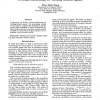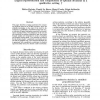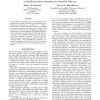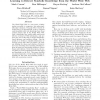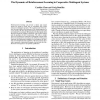AAAI
1998
15 years 2 months ago
1998
In this paper, we develop a formal methodology for verifying situated agents. The methodology consists of two elements, a specification language for specifying the agent capabilit...
AAAI
1998
15 years 2 months ago
1998
This paper describes a logical machineryfor computing decisions based on an ATMSprocedure, wherethe available knowledgeon the state of the world is describedbya possibilistic prop...
AAAI
1998
15 years 2 months ago
1998
89
Voted
AAAI
1998
15 years 2 months ago
1998
The paper presents a constructive 3-valued semantics for autoepistemic logic (AEL). We introduce a derivation operator and de ne the semantics as its least xpoint. The semantics is...
AAAI
1998
15 years 2 months ago
1998
A central problem in learning in complex environmentsis balancing exploration of untested actions against exploitation of actions that are known to be good. The benefit of explora...
118
Voted
AAAI
1998
15 years 2 months ago
1998
In this paper, we describe methods for e ciently computing better solutions to control problems in continuous state spaces. We provide algorithms that exploit online search to boo...
AAAI
1998
15 years 2 months ago
1998
Unit resolution is arguably the most useful known algorithm for tractable reasoning in propositional logic. Intuitively, if one knows a, b, and a b c, then c should be an obviou...
114
click to vote
AAAI
1998
15 years 2 months ago
1998
The World Wide Web is a vast source of information accessible to computers, but understandable only to humans. The goal of the research described here is to automatically create a...
100
click to vote
AAAI
1998
15 years 2 months ago
1998
This paper describes design criteria for creating highly embedded, interactive spaces that we call Intelligent Environments. The motivation for building these systems is to bring ...
112
click to vote
AAAI
1998
15 years 2 months ago
1998
Reinforcement learning can provide a robust and natural means for agents to learn how to coordinate their action choices in multiagent systems. We examine some of the factors that...
